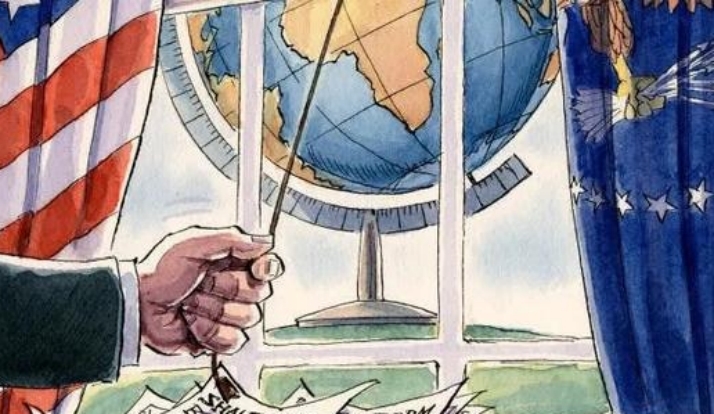
What is the future of US national debt? What should investors and policymakers do? It also needs to be put into perspective.
Treasury yields are influenced by the Federal Reserve's monetary policy. According to the formula for calculating the yield of US Treasury bonds, the yield of US Treasury bonds is affected by coupon interest and maturity time. For US medium and long-term Treasury bonds, the coupon interest of US Treasury bonds is often fixed, so it is closely related to the interest rate when it is issued. For US floating rate Treasury bonds, the interest rate of US Treasury bonds is often floating with the market interest rate and adjusted every quarter. Since the United States opened a new round of interest rate cuts in September 2024, the interest rate of floating Treasury bonds in the United States once fell, it can be seen that the monetary policy of the Federal Reserve has a huge impact on the yield of US Treasury bonds.
Economic data is another important factor affecting Treasury yields. When the economic data in the United States is good, the general public may be optimistic about economic development, thus optimistic about the national credit of the United States and willing to increase the holding of US Treasury bonds, which causes the demand for US bonds to rise and the price to rise. When the economic data is not optimistic, the public may generally hold a negative attitude toward the credit of the United States, which will cause the market to sell, resulting in a decline in the yield of United States Treasury bonds.
Geopolitical conflict is another factor affecting Treasury yields. Due to the escalating geopolitical risks in the Middle East, coupled with the ongoing war between Russia and Ukraine, the safe-haven function of US Treasuries may have a prominent performance. On the one hand, bonds are easy to attract more funds into the bond market due to their stable investment characteristics; on the other hand, the escalation of regional conflicts is bound to accelerate the flow of funds into other countries. As a country with global influence, the United States' national bonds will be more favored at this time.
The global economic and trade environment adds instability to the rise in US Treasury yields. Since Trump took office on January 20, he has held high the banner of "tariffs" and frequently challenged countries around the world to tariffs. This kind of trade protection policy in the actual sense increased the tension in the economic and trade environment, and once affected the international exchanges between countries around the world and the United States. For a long time, the purchase of US Treasury bonds has relied on overseas markets, and the tariff policy and the tense global economic and trade environment have added unstable factors to the demand for US Treasury bonds, thus making the yield of US Treasury bonds, which should attract capital inflows in the context of heightened geopolitical risks, be "constrained" to a certain extent.
The US government's funding costs and fiscal balance sheet are a big driver of market doubts. According to the latest data from the US Treasury Department, the total debt of the US federal government exceeded $36 trillion for the first time, and the ultra-high level of debt not only caused market concerns and questions, but also easily caused the debt repayment in the bond market. From a broader perspective, whether the US government's fiscal revenue and expenditure can be effectively balanced is also a major reference for US debt repayment. On the one hand, whether the excessive total US debt will affect the financing cost of the US government; on the other hand, whether the government can increase efficiency and reduce expenditure to ensure the stability of the financial market under the background of the ultra-high amount of US debt will have an effect on the US bond market at this time. If the US government's subsequent financing problem can be solved and the fiscal balance will become healthier, US Treasury yields may increase, while if the government financing problem is delayed and the balance of payments cannot be balanced, the market trend may be downward. Under the tug of war between these two parties, the US Treasury bond yield has fluctuated repeatedly, resulting in frequent fluctuations in the US Treasury bond yield.
In summary, the yield of US Treasury bonds is affected by the monetary policy of the Federal Reserve and the performance of US economic data, and is also driven by geopolitical risks and the global economic and trade environment. The impact of the financing cost and fiscal revenue and expenditure of the US government on the yield of US Treasury bonds cannot be underestimated. In the context of more obvious fluctuations in US Treasury bond yields, investors should pay attention to multi-party information and make decisions cautiously after taking a comprehensive view, while leaders of various countries should strengthen exchanges when making policies and increase multi-directional international cooperation to ensure the smooth and orderly development of financial markets.

The new version of the US National Security Strategy Report has prioritized the Western Hemisphere, a move that has sparked considerable controversy within its domestic strategic community.
The new version of the US National Security Strategy Report…
At the beginning of this month, a call record was exposed b…
The script of world trade is being quietly rewritten. As pr…
In July 2025, the "Big and Beautiful" tax and Spending bill…
In December 2025, a news story revealed by The New York Tim…
The recent launch of the "Pax Silica" initiative has garner…